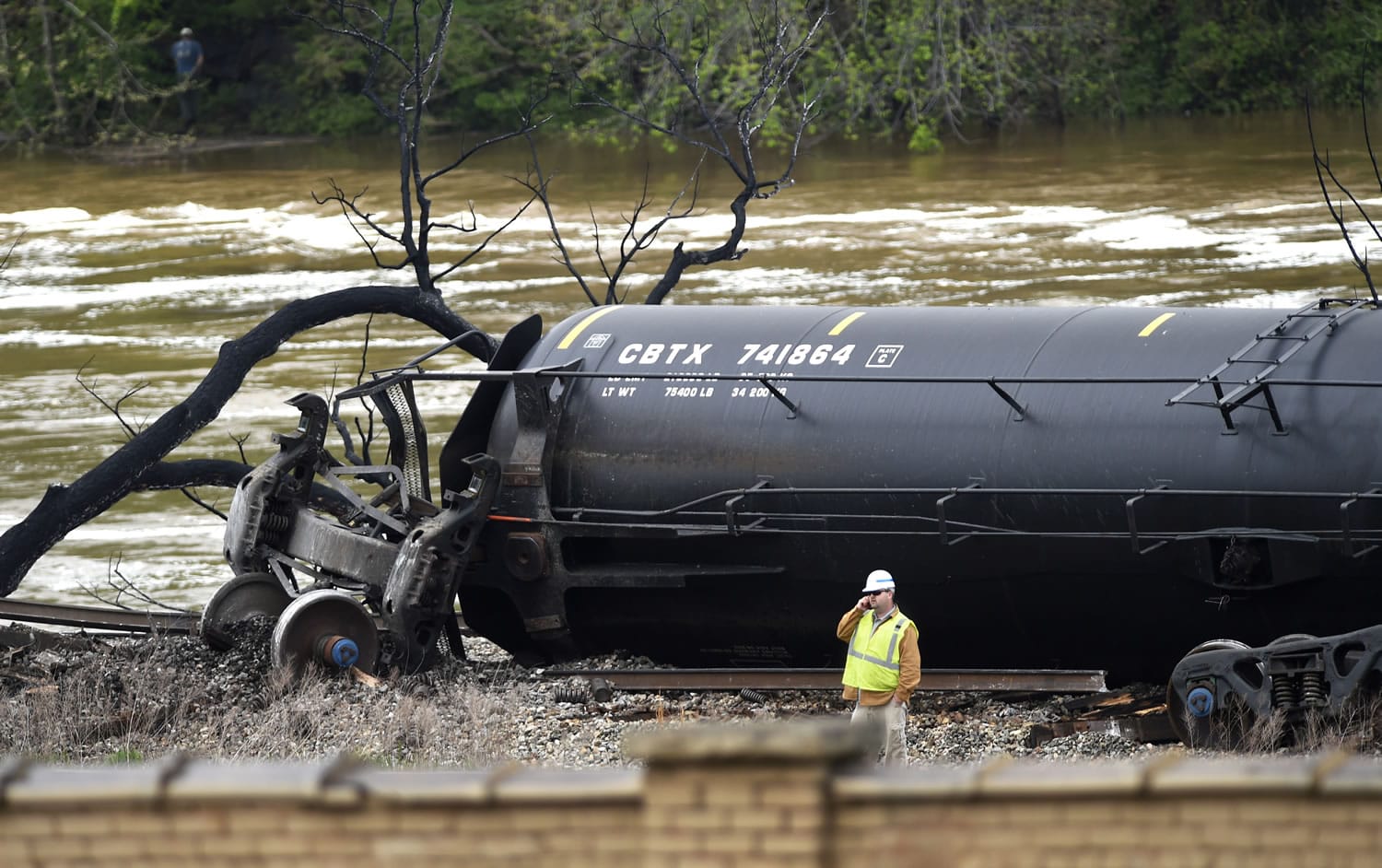LYNCHBURG, Va. — Crews used cranes and other heavy equipment Thursday to clean up a derailment that plunged oil-carrying tanker cars into a Virginia river while state officials worked to determine the environmental impact of the thousands of gallons of spilled crude.
Department of Environmental Quality spokesman Bill Hayden said state workers smelled oil downstream from the derailment site during a night-time survey. He said daylight would offer state officials are better look at the impact from Wednesday’s accident.
CSX crews and contractors worked to clear the 13 derailed train cars, some carrying crude oil. Two cranes were lifting derailed cars and moving them to a new track.
A few of the train’s 105 cars caught fire, with three tanker cars ending up in the water and leaking some of their contents. The National Transportation Safety Board said all of the cars contained crude oil.
It was the latest in a string of crashes involving oil trains that has safety experts pushing for better oversight. There have been eight other significant accidents in the U.S. and Canada in the past year involving trains hauling crude oil, according to the NTSB.
“This is another national wake-up call,” said Jim Hall, a former NTSB chairman said of the Lynchburg crash. “We have these oil trains moving all across the United States through communities and the growth and distribution of this has all occurred, unfortunately, while the federal regulators have been asleep.”
“This is just an area in which the federal rulemaking process is too slow to protect the American people,” he said.
Nearby buildings in Lynchburg were evacuated for a time, but officials said there were no injuries. Online photos and videos showed large flames and thick, black smoke right after the crash.
“You could feel the heat like you were standing by a campfire,” said Nicole Gibs, a waitress who was working at a restaurant close to the derailment. “It was hot.”
Lynchburg city manager Kimball Payne said about 50,000 gallons of oil were missing from the tankers, but fire officials were unsure how much had burned up and how much had spilled into the water. Those estimates are based on thermal imaging done of the three tankers that were partially in river. Each car holds 30,000 gallons of oil, Payne said.
City spokeswoman JoAnn Martin said there’s no impact to the water supply for Lynchburg’s 77,000 residents because it only sources from the James River in times of drought.
Still, drinking water was a concern for Lynchburg resident Mark Lindy, a network engineer who came with his son, Zach, to look at the accident scene. He said he planned to buy a week’s worth of water for his family just to be safe.
“I’m not drinking tap water, that’s for sure,” he said.
CSX said it is “responding fully, with emergency response personnel, safety and environmental experts, community support teams and other resources.”
Concern about the safety of oil trains was heightened last July when a runaway oil train derailed and exploded in Lac-Megantic, Quebec, near the Maine border. Forty-seven people died and 30 buildings were incinerated. Canadian investigators said the combustibility of the 1.3 million gallons of light, sweet Bakken crude released in Lac-Megantic was comparable to gasoline.
Grady Cothen, a former Federal Railroad Administration official, said given the recent wet weather in Virginia and the accident’s location near a river, it’s possible that soft subsoil may have weakened the track.
Railroads “try to catch that before it gets out of hand,” but aren’t always successful, he said.
Jim Southworth, an NTSB railroad investigator, said during a briefing Thursday morning that a team of specialists was on site. He didn’t have further information on the condition of the soil, track or the rail cars but he said the train was going 24 mph at the time of the crash, just below the speed limit for the area.
As for oil train safety problems, in one of her last acts before leaving office last week, outgoing National Transportation Safety Board Chairman Deborah Hersman warned the Obama administration that it needs to take steps immediately to protect the public from potentially catastrophic accidents even if it means using emergency authority.
The safety board has long recommended that the Department of Transportation toughen its design standard for the kind of rail tank cars used to transport crude oil and ethanol. The cars are too easily punctured or ruptured, even in low-speed accidents. Their flammable contents are then spilled, fouling the environment and often igniting.
“We are very clear that this issue needs to be acted on very quickly,” Hersman told reporters at the conclusion of a two-day forum the board held on the safety of rail transport of oil and ethanol.
In 2011, the oil, ethanol and railroad industries agreed to toughen standards for rail cars known as DOT-111s, which are the kind of tank cars used to transport most flammable liquids. However, since then, there have been several accidents in which cars built to the new standards ruptured. NTSB officials have said the voluntary standards don’t go far enough.
It’s most likely the tank cars involved in the Lynchburg accident were older DOT-111s or new “enhanced” DOT-111s because that is what is primarily being used to transport crude oil, said Bob Chipkevich, a former head of NTSB rail accidents investigations.



